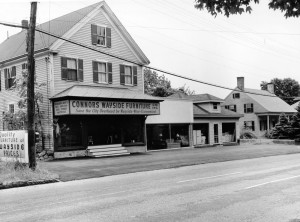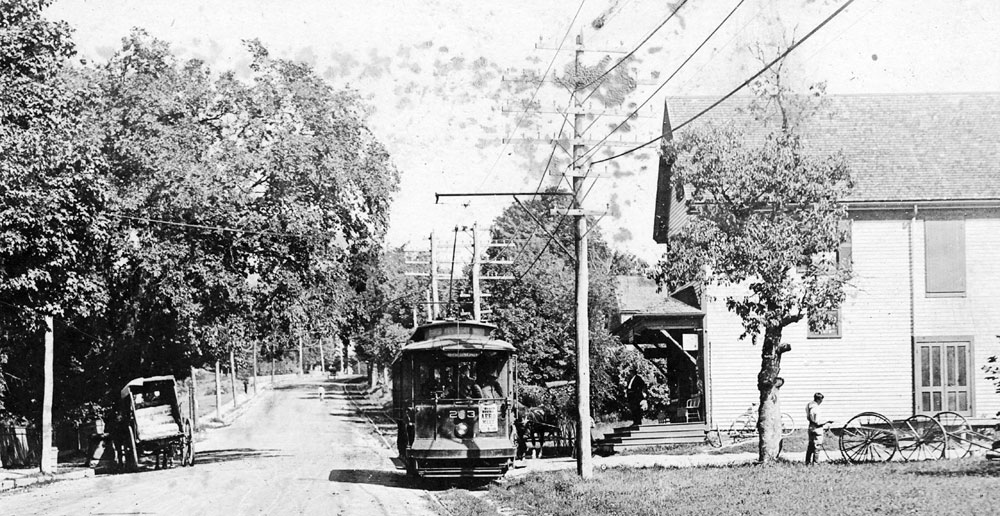True Tales: Horton Hears a Use
By George T. ComeauPaul Folkman and Jim Lamarr are developers. And, quite honestly, being branded a developer in a small town like Canton is usually a bad thing. It is the developers that receive the scorn of neighborhood associations, who see encroachments as personal attacks upon the value of their homes.

Connors Wayside Furniture as it appeared in the 1950s before the store expanded (Courtesy of the Canton Historical Society)
Developers are branded as greedy, irresponsible, and polar opposites of preservationists. Yet in Folkman and Lamarr there is perhaps another side to the story. As there are many developers who deserve our criticisms, there are also responsible businessmen who work to improve and build upon our heritage while respecting the character of Canton. Folkman and Lamarr may be of the latter ilk.
The Route 138 of today is nothing like it was at the turn of the last century. Today, cars and trucks feed the region with doses of exhaust and bleats of horns. It is hard to see this asphalt ribbon as anything like a bucolic country village. But that is exactly what Ponkapoag was right up until the 1950s — a close-knit neighborhood of houses that date to the mid 18th century with a mix of retail that supported the true small village of Canton.
In the early 1800s, Ponkapoag was a magical place. An elderly resident in 1875 wrote to Daniel Huntoon that “there was once a circus at the Punkapog Hotel, about 1826, I should think, I remember many of its details with wonderful distinctness, about 1825, an elephant was driven along and was exhibited in, then George Downs’ barn, for a fo’penny a head.”
This was also the neighborhood where James Bazin invited people into his house to a darkened room that was in fact a camera obscura, and they could see a magic reflection of Ponkapoag cast against the interior walls. In this neighborhood the wealthy mayor of Boston lived side by side with immigrant families and the descendants of patriots of the American Revolution.
To be clear, Ponkapoag is the oldest and perhaps — historically speaking — the beginning of what is now Stoughton and Canton. And while it may seem today like a plucky little gateway to Washington Street, it is in fact worthy of preservation and attention to detail. Enter Folkman and Lamarr.
Today we know the site as Connors Wayside Furniture — a rambling complex of storefronts, additions, and a warren of small showrooms packed onto a site all too close to Route 138. Everyone in the day bought furniture at Connors. In a conversation with Mayor Menino several years ago, this author remarked that he hailed from Canton. Menino and his wife Angela’s face brightened, and they proudly extolled the virtues of Connors Wayside Furniture and the sofa that graced their living room that came all the way from Canton to West Roxbury.
Connors is a newcomer to Ponkapoag. Opened in 1941 by Leonard Connors, the business started in a rented storefront and closed a few years later when Connors was drafted during World War II. After the war, when Connors returned to Canton, he purchased the building and an adjacent building, which housed the Haynes Garage. The purchase includes a series of old small buildings, one of which had housed an automobile showroom for new Pontiac and Oakland cars. In 1943, Connors began to build his business, and over the course of more than 55 years there were no fewer than eight building additions. Business in post-war Canton was booming, and Connors Wayside Furniture boasted a large sign that advertised quality furniture at “Wayside Prices.” Connors reduced its hours a few years ago and has been marketed for sale ever since. Folkman and Lamarr are now working through permitting to create condominiums on the site.
If you look closely at the building today, you will see the vestiges of a particularly old-fashioned entrance to the building — a few wooden steps, an awning, and a pair of Queen Anne style turned brackets. While much attention is turned on Connors, more attention is about to be turned onto the original use of this building, that of the Horton Store. Is there a way to save the historic structure, and still develop 21st century amenities that residential buyers demand?
The original core of this commercial block was likely built in 1899-1905 by Lawrence Horton as a grocery store on the site of an earlier store of Billings & Horton. Not even hidden, simply forgotten, is the original Horton Store, and it is of exceptional value as a rare surviving early 20th century commercial storefront along Route 138 in Canton. Still intact with original vault alarm and plate glass windows, the building is worthy of saving. The charm and history is not lost on the pair of developers, who hope to transform the property into a residential use.
The way that Folkman tells the story, he and his partner looked long and hard at the property and never considered demolishing the building. “We looked at the building as a clean slate,” explains Folkman. “The first thing we did was bring in a structural engineer to see if we could adapt this space into our project.” The appeal to the developers was simply an intuitive reaction. There was no person at that point in the process who even spoke for the history of the building; they just knew that there was something worth saving.
Folkman and Lamarr are no strangers to adaptive reuse — the practice of reusing an old site or building for a purpose other than which it was built or designed and which is regarded as a compromise between historic preservation and demolition. These same developers helped save a schoolhouse in Middleboro that was built in 1855 and developed luxury condos around a Victorian mansion in Mansfield. So in Canton they brought forth plans to the Zoning Board of Appeals to build 32 units into the space, while retaining just about all of the existing building. Needless to say, in Canton, the ZBA saw many problems with the proposal, not the least of which was density.
Paul Schneiders has been a zoning attorney since the start of zoning … well, not quite. But it is fair to say that zoning and development can be quite controversial, and Schneiders is usually in the center of the fray. Of this project, the eminent attorney is very excited.
“As a zoning lawyer, I like the fact that the proposed use is residential,” explains Schneiders. “We vetted eight potential commercial interests, but residential is closer and in the spirit and heading back to what this neighborhood once was.”
Folkman agrees, and after the initial meeting with the ZBA, he and his partner went back to the drawing boards, quite literally, to bring a second draft to the town. “We hired a new architect and brought in a landscape architect who is a top talent in order to bring green space to the site,” said Folkman. To back up their words, Folkman and Lamarr developed a substantial budget for trees and plants to grace the new site that will feature 26 units, down from the original 32. The new proposal retains almost 90 percent of the original structures and allows for less density and a design that will please preservationists and neighbors.
The friction between developers and neighbors generally turns on issues such as density, traffic, and compatibility. It is likely that even with the reduction in units, this will still be the case. Here, however, we see a site that sits just a few thousand feet from a major interstate highway, and on the state highway that runs to Tiverton, Rhode Island. Any argument that this proposed use is extreme quickly loses wind to that fact that more than 2,700 cars per hour travel by this property during the morning and evening peak commute. The impact of density here is negligible even given the proposed development at the former site of the A.A. Will gravel pit about a mile away.
Yet for a historian and someone who sees great promise in preserving our past, this author cannot fail to appreciate that someone looked at this building and found elements worthy of preservation. The Ponkapoag Post Office, G.M. Davenport’s Store, and the public library annex once occupied this site. This was the site where Thomas Bailey Aldrich opened Mark Twain’s letters and satire ensued. This was the place where Billings and Horton ran a general store that dated back to at least 1855. The property changed hands several times within a short period beginning in 1869, when George Frederick Handel Horton, a sign painter, sold it to George Davenport. By 1873 Davenport sold the site to Charles Stretton, a manufacturer of knit underwear, who later moved to Stoughton. Largely the 19th century buildings were replaced in the late 1890s. By 1899, the period storefront we see today was constructed and is now the subject of a new design that will become one of the nicest units in the proposed developments.
There can be no preservation without a use. In other words, the things we save must be worth saving and have usefulness that current and future generations will value and therefore preserve. The Horton Store is worthy of saving, and in the hands of responsible developers we should look forward to the new project as a historic nod to adaptive reuse.
The Canton Zoning Board of Appeals takes up the next presentation of this project on December 4.
Related Content
Local builder helps rehab lives through nonprofit work
Connors property eyed for condo development
Short URL: https://www.thecantoncitizen.com/?p=27657











